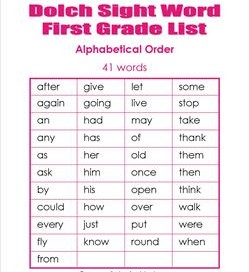

HIGH FREQUENCY SIGHT WORDS FIRST GRADE HOW TO
The teacher told us that she, her students, and their parents were thrilled that they were no longer “banging their heads against the wall” going over and over the words as students tried to memorize how to read or spell high-frequency words with little success. Students also soon stopped confusing was and saw because they learned to think about the first sound before reading or spelling those words. With this approach, students had an easier time learning to read the word said because they knew that only the letters ai are an unexpected spelling. We integrated 2 or 3 of these words into a phonics lessons, and students learned to identify the letters spelled as expected and to learn “by heart” the letters not spelled as expected. These words have two or three letter sounds students knew and only one or two letters that had to be memorized. Next, we identified irregularly spelled high-frequency words such as said, you, and from. First, we focused on identifying decodable high-frequency words such as but, him, and yes and integrating them into phonics lessons instead of teaching them as words that had to be memorized. Together with the teacher, we organized the high-frequency words to fit into the phonics lessons so that the words were tied to spelling patterns students were learning. We suggested that the students learn high-frequency words according to spelling patterns, and not according to frequency number or theme. These students could read words that followed spelling patterns they had learned and practiced, but they struggled learning words that made no sense to them from a sound–spelling viewpoint. (Indeed, they were having difficulty reading all the high-frequency words in the lists.)

All four students had difficulty reading those words when they were mixed into lists with other high-frequency words. None of the four students could spell more than two of the words accurately. The high-frequency words the students were responsible for knowing in this lesson were the color words: blue, red, yellow, orange, purple, and green. Her students had learned to read CVC words and this was their first lesson with digraphs. We observed her teaching the digraph th to a group of four Tier 3 first grade students. It is as if the high-frequency words are a special set of words that need to be memorized and can’t be learned using sound–symbol relationships.Ī number of years ago, a teacher we respect enormously asked for help because many of her Tier 2 students and all of her Tier 3 students in first and second grades were failing to learn high-frequency words, even though they were progressing in their phonics lessons. For years we have been struck that even schools embracing research-based reading instruction teach high-frequency words through rote memorization. We have visited many schools to observe intervention lessons and core reading instruction.


 0 kommentar(er)
0 kommentar(er)
